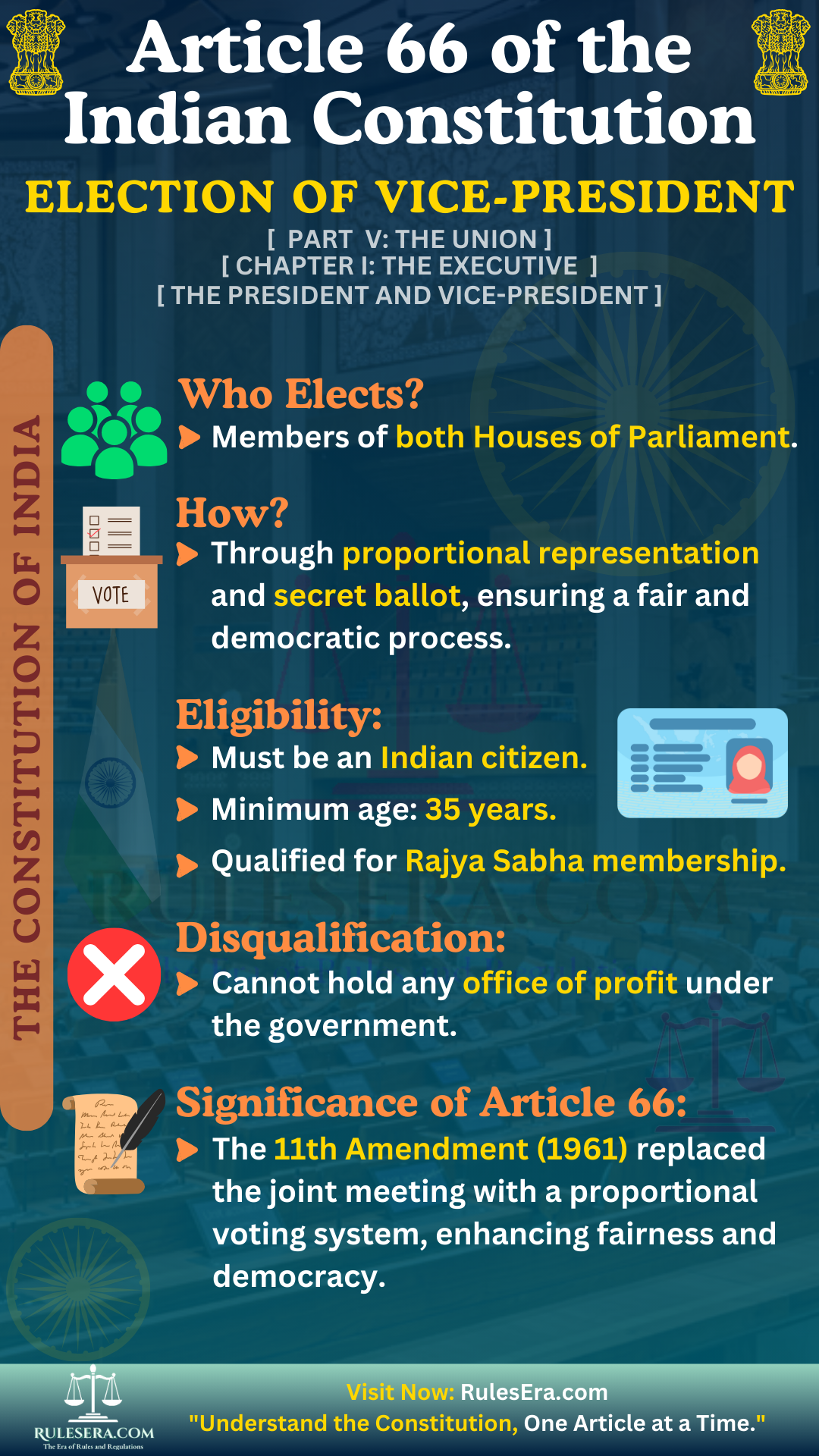Part V: The Union
Chapter I: The Executive
Article 66: Election of Vice-President

--- Original Article ---
(1) The Vice-President shall be elected by the members of an electoral college consisting of the members of both Houses of Parliament in accordance with the system of proportional representation by means of the single transferable vote, and the voting at such election shall be by secret ballot.
(2) The Vice-President shall not be a member of either House of Parliament or of a House of the Legislature of any State. If a member of either House of Parliament or a House of the Legislature of any State is elected Vice-President, they shall be deemed to have vacated their seat in that House on the date on which they enter upon office as Vice-President.
(3) No person shall be eligible for election as Vice-President unless they:
- Are a citizen of India
- Have completed the age of thirty-five years
- Are qualified for election as a member of the Council of States (Rajya Sabha)
(4) A person shall not be eligible for election as Vice-President if they hold any office of profit under the Government of India, any State Government, or any local authority. However, being the President, Vice-President, Governor, or a Minister is not considered an office of profit.
Explanation: For the purposes of this article, a person shall not be deemed to hold any office of profit by reason only that they are the President or Vice-President of the Union, the Governor of any State, or a Minister either for the Union or for any State.
Explanation of Key Provisions
Clause (1) – Electoral College and Proportional Representation
The Vice-President is elected by an electoral college comprising members of both Houses of Parliament. The election is conducted in accordance with the system of proportional representation by means of the single transferable vote. This system was amended by the Constitution (Eleventh Amendment) Act, 1961, which replaced the earlier requirement of a joint meeting of Parliament members with the proportional system.
Clause (2) – Non-membership in Parliament or State Legislature
The Vice-President, once elected, must vacate any seat held in either House of Parliament or in a State Legislature. This ensures that the Vice-President’s responsibilities remain separate from legislative functions, thus maintaining impartiality.
Clause (3) – Eligibility Criteria
To be eligible for election as Vice-President, a candidate must be:
- A citizen of India
- At least thirty-five years old
- Qualified for election as a member of the Council of States (Rajya Sabha)
Clause (4) – Disqualifications: Holding Office of Profit
A candidate is disqualified from running for Vice-President if they hold any office of profit under the Government of India, any State Government, or any local authority, ensuring that a person is not using their governmental role for electoral gain.
Real-Life Example
In 2017, Venkaiah Naidu was elected as the Vice-President of India. He resigned from his seat in the Rajya Sabha immediately upon election, demonstrating Clause (2) in action. The recent election of Jagdeep Dhankhar as Vice-President in 2022 was conducted through the proportional representation system, reflecting the inclusiveness of the voting mechanism under Article 66.
Legislative History
Article 66 was initially formulated as Article 55 of the Draft Constitution and discussed on December 28 and 29, 1948, and October 13, 1949, before being incorporated into the final Constitution in 1950. The Constitution (Eleventh Amendment) Act, 1961 introduced a significant modification by modernizing the election process.
Debates and Deliberations
During the Constituent Assembly debates, various proposals were made to refine the election process for the Vice-President:
- Prof. K. T. Shah argued that the election process should mirror the President’s and involve State Legislatures for fairness.
- Mr. Mohd. Tahir supported this view, emphasizing the need for consistency in electing both offices.
- Mr. Naziruddin Ahmad suggested removing the joint session and proportional representation, deeming it unsuitable for single-seat elections.
- Shri L. Krishnaswami Bharathi proposed replacing "proportional representation" with "alternative vote" to better describe the election for single-member constituencies.
However, Dr. B. R. Ambedkar defended the provisions, stating that since the Vice-President's role was primarily to preside over the Council of States, the involvement of State Legislatures was unnecessary. He supported proportional representation to ensure fairness, transparency, and prevent manipulation. On October 13, 1949, Shri T. T. Krishnamachari clarified that positions like President, Vice-President, Governors, or Ministers were not considered "offices of profit," enabling these officeholders to contest for Vice-President.
Ultimately, Article 66 was incorporated with these refinements, reflecting a balanced approach to the election process, preserving democratic fairness, and ensuring practicality in governance.
Frequently Asked Questions (FAQs):
The Vice-President is elected by members of both Houses of Parliament through proportional representation using the single transferable vote.
No, once elected, the Vice-President must vacate any seat held in Parliament or in a State Legislature to ensure separation of powers.